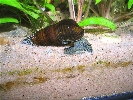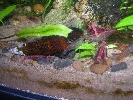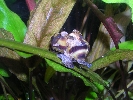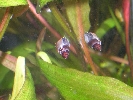Assassin Snails and Sulawesi Elephant Snails: Keeping Clea and Tylomelania in the aquarium
By Neale Monks © 2009
The Assassin Snail (Clea helena) has been welcomed by fishkeepers as the single best all-around snail-killing animal in the hobby. Existing choices were limited to things like pufferfish and the larger loaches, particularly botiine loaches, but these fish are often difficult to maintain, and in the case of puffers especially, tend to be nippy towards their tankmates. The Assassin Snail is very different. It is small, completely harmless towards fish and shrimps, and generally very easy to keep. It is also very pretty, bright yellow with chocolate brown stripes.
Clea helena shells
The various species of Tylomelania imported from the Southeast Asian island of Sulawesi are not kept to do a job, but because they’re interesting and attractive. In the past aquarists have kept Apple Snails (Pomacea spp.) but these don’t always do well. In the wild most Apple Snails spend a few months resting in the mud, but they can’t do this in an aquarium, and because of this seem to ‘burn up’, dying within a year or so and never attaining full size. Tylomelania spp. do much better in aquaria, and unlike Apple Snails, they do not eat plants, so can be kept in planted tanks without risk.
Tylomelania sp., “Yellow Helmet Snail”
Are these the perfect aquarium snails? Quite possibly!
Taxonomy
Clea helena is sometimes called Clea (Anentome) helena or Anentome helena. It is a member of the whelk family Buccinidae, and one of very few whelks that lives its entire life in freshwater habitats. Common names in the trade include Assassin Snail and Snail-eating Snail.
Tylomelania are members of the family Pachychilidae, a freshwater-dwelling group within the predominantly marine Cerithioidea superfamily of gastropods. There are numerous Tylomelania species, and telling them apart is difficult. Many retailers simply sell them as Tylomelania, or else under trade names such as Sulawesi Elephant Snails, Helmet Snails, Rabbit Snails and various other names.
Ecology in the wild
Clea are whelks, most of which live in the sea. Like their marine relatives, Clea are opportunistic carnivores that feed on both live prey and carrion. Among the prey taken are snails, and it is this that has made them popular with fishkeepers. Clea stay partially hidden under the sediment, and if a snail slides past, then quickly (by snail standards) jump into action, chasing their prey and eventually subduing it.
Most Clea live in clean, fast-flowing streams where they can be found in sandy or muddy substrates. Clea helena is exceptional in being found in ponds and ditches too, and its tolerance for a wider range of water conditions is probably why this one particular species does so well in captivity.
Clea helena lurking in the sand
Tylomelania spp. are primarily inhabitants of lakes and rivers. They are more scavengers than carnivores, and feed on various types of decaying organic matter besides carrion. They also eat some algae, though they are less dedicated algae-eaters than, say, Nerite snails, which seem to eat nothing else.
What makes Tylomelania so remarkable is their size and variety. Their shells come in a range of shapes and sizes, the biggest ones more than 10 cm (4 inches) in length. Ornamentation consists of different arrangements of ribs and grooves. The soft body of the animal is variable too, and can be yellow, green, grey or black.
Water chemistry and water quality
Like most other snails, Clea helena and Tylomelania spp. will not do well in water that is too soft or acidic. While the precise water chemistry values do not seem to be important, aim for moderately hard to hard water with a pH above neutral (10-20 degrees dH, pH 7-8).
These are true freshwater snails and do not need salt added to the water. But having said that, the authors experience is that both Clea helena and Tylomelania spp. tolerate slightly brackish water conditions (around SG 1.003) perfectly well.
Tylomelania spp. do well in moderately hard, slightly basic water
Water quality is important, particularly in the case of Tylomelania. These are not species for immature aquaria, and are best added after the aquarium has been running for at least a couple of months. Unlike the other freshwater snails kept by hobbyists, such as Apple Snails, these are not air-breathing snails, and they will not do well in tanks with poor water circulation or inadequate oxygen.
Substrate
Clea helena is a burrowing species, and does best in tanks with a sandy substrate. If nothing else, this gives the aquarist an opportunity to watch the natural behaviour of the species. It is also more likely to reproduce successfully in a tank with a sandy substrate since the juvenile snails seem to spend a lot of time hidden underground. Perhaps they need to avoid being eaten by the adults?
Juvenile Clea helena spend their first few months in the substrate, hidden from view
Tylomelania are less fussy and do well in tanks with either sand or gravel substrates. If sand is provided, they will root about a bit more naturally, and this is fun to watch, but they don’t seem overly bothered by gravel substrates. Tylomelania will breed successfully in tanks with either type of substrate.
Diet
Feeding these snails is extremely easy, since both species consume any meaty food they find, including uneaten fish food. To a degree then, they’re scavengers. But for optimal health they will need some food left out specifically for them. Catfish pellets are a good staple, but these could be augmented with calcium-rich fare that will help them build their shells. Wet-frozen brine shrimp, mysis and krill all seem to be very popular. Small pieces of frozen lancefish are also welcomed, especially the more bony bits like the head that fish tend to ignore.
Tylomelania snail feeding on an algae wafer (alongside Cherry Shrimps)
Breeding
Clea helena is not difficult to breed, though it does so slowly, and isn’t likely to become a pest in the same was as many other snails. For one thing, being carnivorous, it is fussier about food, and that means an aquarium of given size will support a much smaller population of Clea helena than omnivorous or herbivorous snails.
It is not possible to tell male and female Clea helena apart, so to start breeding them, a small group will be necessary. When Clea helena mates, pairs or groups of snails clamber over each other and seem to hold position like that for hours at a time. Eventually the males and females separate, and the females go off to lay their eggs. Eggs are deposited one at a time in tiny transparent blobs, usually on solid objects such as bogwood roots. Hatching takes a few weeks, and it is fully six months before the juveniles are big enough (around 8 mm) to be seen actively hunting at the surface. Before they get that big they are presumably hidden away in the sand feeding on whatever small organisms they find there. Lifespan is around two years.
Two Clea helena mating
Tylomelania spp. are almost but not quite livebearers. Again, males and females are separate, so for breeding purposes a group is required. There is no easy way to sex them. Once mating has taken place, the female broods the eggs internally almost to the point when they are ready to hatch. The eggs are then released, and within an hour than juvenile snail crawls out from the shell. At this point the juvenile has a shell that is a good 5 mm in length, and can be reared alongside the adults without problems. They are, however, vulnerable to predation by Clea helena, so while adults of both species can be mixed, you won’t get many Tylomelania if they’re kept together.
A very young Tylomelania snail
Tankmates
Clea helena is a predator, and it will eat any small snails it can catch. It will likely eat fish eggs too, and quite likely immobile (“wriggler”) fish fry too. But otherwise Clea helena is an excellent community tank resident. It does not harm snails that are substantially larger than it is, and things like adult Nerite Snails as well as Tylomelania seem to coexist amicably enough. Fish are at no risk at all once mobile, and even livebearer fry are ignored.
Tylomelania spp. are essentially non-predatory so far as aquarium fish and invertebrates go.
On the other hand, like all snails, Clea helena and Tylomelania spp. are vulnerable to predation when kept with large fish. Cichlids, pufferfish, loaches and certain catfish (e.g., Synodontis) are likely to view Clea helena and the smaller Tylomelania as potential food. Even if they don’t eat them outright, fish that like to peck at things may stress these snails sufficiently that they’ll cause damage and eventually death.
Good companions are things like tetras, non-nippy barbs, rainbowfish, livebearers, Corydoras catfish, bristlenose catfish and so on.
Clea for snail control
Clea helena are known as Assassin Snails and Snail-eating Snails precisely because they’re so good at catching and killing small snails. Are they worth using though? In short, yes, but you will need quite a few of them.
In the author’s experience, controlling a runaway Malayan Livebearing Snail (or Malayan Trumpet Snail, Melanoides tuberculata) is to use 4-6 Clea helena per 60 litres (about 15 US gallons) of water. While they won’t exterminate every last one of the Malayan Livebearing Snails, the Clea helena will keep the population of them small enough that they’re no longer troublesome.
Melanoides tuberculata is readily eaten by hungry Clea helena
Besides Malayan Livebearing Snails, Clea helena will also eat other small snail species including Physa spp. (Tadpole Snails). They will also eat juvenile Tylomelania snails, and that may be an issue if you want to keep them together.
Tylomelania as a scavenger
Tylomelania are excellent scavengers and a good choice for the aquarist after a snail that will consume uneaten fish food and organic detritus. They are especially good at cleaning up any leftover bones and shells, as well as things like shrimp moults.
Of course no snail actually “cleans” an aquarium, and that remains the job of the filter (as well as the weekly water changes). But Tylomelania seem to be able to compete reasonably well with things like Corydoras catfish, and aquarists might even consider using these snails, perhaps alongside shrimps, as the only bottom feeders in the aquarium.
Close
Tylomelania spp. and Clea helena have much to attract the aquarist keeping small, gentle freshwater fish. Compared to the existing species on offer, these snails are far less likely to become a pest, and once settled in, hardy and easy to maintain. While we’re not quite at the stage of having a freshwater reef tank just yet, these snails are a good few steps in that direction!
|
Snails in Freshwater Aquariums on WWM
Related Articles:
Snails and
Freshwater Aquariums by Bob Fenner, Invertebrates
for Freshwater Aquariums by Neale Monks,
Fresh and Brackish Water Nerites by Neale
Monks, Assassin
Snails and Sulawesi Elephant Snails. Keeping Clea and Tylomelania in the
Aquarium by Neale Monks, Related FAQs: Freshwater Snails 1, Freshwater Snail Identification, Freshwater Snail Behavior, Freshwater Snail Compatibility, Freshwater Snail Selection, Freshwater Snail Systems, Freshwater Snail Feeding, Freshwater Snail Disease, Freshwater Snail Reproduction, Snails by Species: Mystery Snails, Apple/Baseball Snails, Malaysian/Trumpet Snails, Ramshorn Snails, |
|













